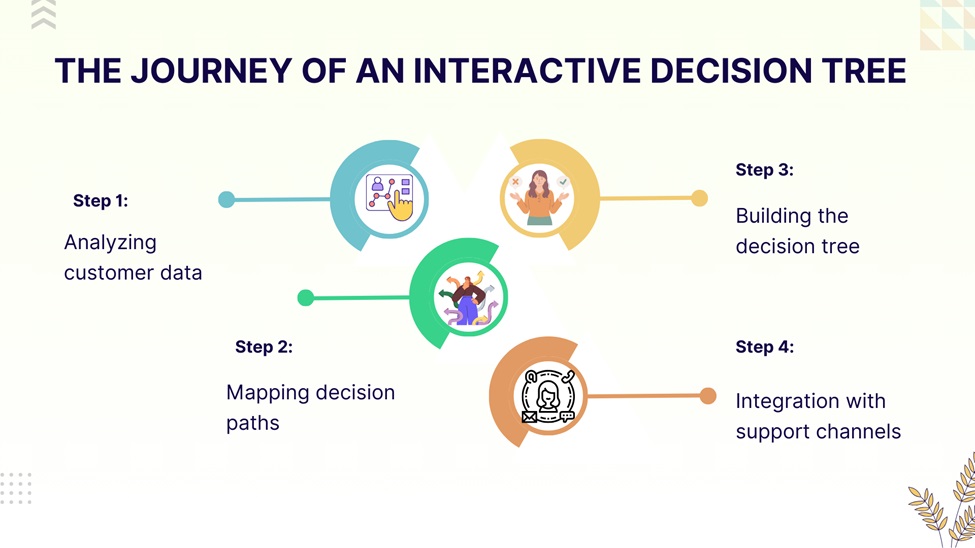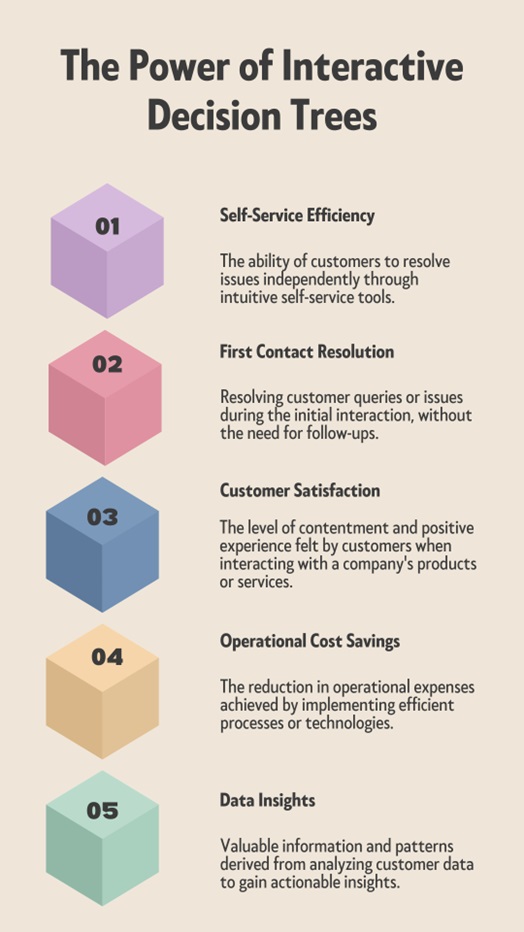7 Ways Interactive Decision Trees Revolutionize Customer Support
Customer support has evolved dramatically over the years, transitioning from traditional call centers to modern, automated, and intelligent systems focused on delivering seamless customer experiences.
One such innovation that is transforming the landscape is the rise of interactive decision trees. These dynamic, guided tools are revolutionizing how businesses approach customer support, offering a multitude of benefits that enhance efficiency, customer satisfaction, and operational effectiveness.
Introduction to Interactive Decision Trees
Interactive decision trees serve as powerful tools guiding customers through a logical sequence of questions and prompts, leading to tailored solutions for their specific needs. These dynamic tools offer an intuitive and personalized self-service experience, revolutionizing the way businesses approach customer support.
How to Make a Decision Tree
Creating an effective interactive decision tree is a multi-step process that requires careful planning and execution. The first crucial step is to thoroughly analyze customer data, support logs, and feedback to identify the most common issues, pain points, and frequently asked questions. This helps businesses understand the key areas where decision trees can have the greatest impact.
Once the target issues are defined, the next step is to map out the logical decision paths that will guide customers to the appropriate solutions. This involves breaking down complex problems into a series of simple yes/no questions or multiple-choice prompts. The structure should be intuitive and easy for customers to navigate, covering all possible scenarios and edge cases.
To build the actual decision tree, businesses can leverage specialized decision tree tools or interactive decision tree maker software. These platforms typically offer a user-friendly, visual interface that allows teams to drag-and-drop elements, create branches, and define solution nodes. Advanced tools may also include features like version control, collaboration capabilities, and testing environments to ensure the decision tree functions as intended.
After designing the decision tree, the final step is to integrate it seamlessly into existing customer support platforms and channels. This could involve embedding the tree on a website, incorporating it into a mobile app, or integrating it with customer relationship management (CRM) systems, or chatbots. Seamless integration ensures a consistent and cohesive experience for customers, regardless of the touchpoint they use.

Benefits of Interactive Decision Trees
By empowering customers to create interactive decision trees tailored to their needs, businesses can enhance self-service efficiency, streamline support processes, increase first-contact resolution rates, boost customer satisfaction and loyalty, reduce operational costs, collect valuable data insights, and future-proof their customer support strategy.
Enhancing Self-Service Efficiency
Interactive decision trees take self-service capabilities to new heights by providing an intuitive, step-by-step guided experience. Unlike traditional FAQ pages with static information, decision trees dynamically adapt based on the customer's responses, offering personalized solutions tailored to their specific situation.
This approach empowers customers to navigate through complex issues confidently, increasing the likelihood of resolving their problems independently and reducing the need for agent involvement.
Streamlining Support Processes
By encapsulating best practices and standardized troubleshooting procedures, interactive decision trees ensure that support agents follow a consistent, optimized path when assisting customers. This structured approach minimizes variability in service delivery, reduces the risk of human error, and enhances overall process efficiency.
With decision trees guiding the interaction, agents can swiftly gather relevant information, identify the root cause, and provide accurate solutions, ultimately reducing average handling time and improving productivity.
Increasing First Contact Resolution (FCR) Rates
Achieving a high FCR rate is crucial for delivering exceptional customer support and minimizing operational costs. Interactive decision trees contribute significantly to improving FCR rates by ensuring that customers receive comprehensive and accurate solutions during the initial interaction.
By leveraging decision trees' ability to capture intricate problem-solving logic and present tailored resolutions, businesses can minimize the need for follow-up interactions, thereby leading to higher customer satisfaction and reduced operational overhead.
Enhancing Customer Satisfaction and Loyalty
Customer satisfaction and loyalty are paramount for any business's long-term success. Interactive decision trees play a pivotal role in fostering positive customer experiences by delivering prompt, personalized support that addresses each individual's unique needs.
Customers appreciate the convenience and efficiency of being guided through a logical problem-solving process, whether through self-service or agent-assisted interactions. This elevated level of support not only enhances satisfaction but also strengthens customer loyalty and advocacy for the brand.
Reducing Operational Costs
One of the most compelling benefits of interactive decision trees is their ability to reduce operational costs associated with customer support. By enabling self-service resolution of common issues and streamlining agent processes, businesses can minimize the need for live agents, resulting in substantial labor cost savings.
Furthermore, the structured nature of decision trees reduces training requirements for new agents, further contributing to cost optimization.
Collecting Data and Insights on Customer Needs
Interactive decision trees serve as invaluable sources of data and insights into customer behavior, preferences, and pain points. By analyzing the paths customers take through decision trees, businesses can identify common issues, frequently asked questions, and areas where additional support or product enhancements may be needed.
This data-driven approach empowers organizations to make informed decisions, continuously improve their products and services, and proactively address customer needs, fostering a customer-centric culture.
Future-Proofing Customer Support
As technology continues to evolve, interactive decision trees represent a future-proof solution for customer support. With their inherent flexibility, decision trees can seamlessly integrate with emerging technologies such as AI decision trees, machine learning, and natural language processing (NLP). This integration enables decision trees to handle increasingly complex customer interactions, adapt to changing customer preferences, and provide predictive support mechanisms, ensuring that customer support remains at the forefront of innovation and delivers exceptional experiences.
Moreover, the ability to Create a Decision Tree that can continuously learn and improve through AI and machine learning capabilities ensures that businesses can stay ahead of the curve and provide cutting-edge support solutions. As customer expectations evolve, AI-powered decision trees can be updated and refined to meet new demands, without the need for complete overhauls or replacements.
By embracing interactive decision trees and their integration with AI technologies, businesses can future-proof their customer support strategies, positioning themselves as leaders in delivering seamless, personalized, and intelligent support experiences for years to come.

Comparison Table: Traditional vs. Interactive Decision Trees
To highlight the advantages of interactive decision trees over traditional customer support methods, consider the following comparison:
|
Feature |
Traditional Support |
Interactive Decision Trees |
|
Self-Service Capabilities |
Limited, static FAQ sections |
Guided, personalized self-service journeys |
|
First Contact Resolution |
Lower due to lack of personalization |
Higher due to tailored solutions |
|
Agent Efficiency |
Longer handling times, higher training costs |
Structured troubleshooting, reduced training needs |
|
Operational Costs |
Higher due to increased staffing needs |
Lower due to automated processes |
|
Data Insights |
Limited to call logs and transcripts |
Comprehensive data on customer behavior and preferences |
|
Future-Proofing |
Limited scalability and adaptability |
Seamless integration with emerging technologies like AI |
Frequently Asked Questions
1. How do interactive decision trees differ from traditional FAQ pages?
Traditional FAQ pages offer static, predefined answers to common questions, while interactive decision trees provide a dynamic, personalized journey by guiding customers through a series of prompts and logical paths to arrive at tailored solutions. Decision trees offer a more intuitive and engaging self-service experience.
2. Can decision trees be integrated with existing customer support software?
Yes, most reputable decision tree software solutions are designed to seamlessly integrate with popular customer support platforms, such as Salesforce, Zendesk, and Freshdesk. This integration allows for a unified customer experience and streamlined data management.
3. Are interactive decision trees suitable for all types of businesses?
Interactive decision trees are highly scalable and customizable, making them suitable for businesses across various industries and sizes. Decision trees can be tailored to address the unique support needs of any organization, ranging from e-commerce and software companies to financial institutions and healthcare providers.
Conclusion
Interactive decision trees have emerged as a game-changing solution for modern customer support, revolutionizing how businesses approach customer interactions. By enhancing self-service efficiency, streamlining processes, boosting first-contact resolution rates, and reducing operational costs, these dynamic tools offer multifaceted advantages to businesses.
Moreover, their ability to collect valuable data insights and integrate with cutting-edge technologies like AI ensures that decision trees remain future-proof. As customer expectations continue to evolve, embracing innovative solutions like interactive decision trees is imperative for businesses to stay ahead of the curve and deliver exceptional, personalized support experiences.

